Dra. Lida Prypchan
Psychiatrist & Writer — Writing and meditating at the intersection of psychiatry, philosophy, Buddhism and the arts.
Dr. Prypchan was trained at the University of Carabobo as a doctor; as a psychiatrist at the Central University of Venezuela, Harvard University and the Monte Sinai School of Medicine in New York City, where she also worked for two years in Child and Adolescent Psychiatry.
Dr. Prypchan writes about the interrelationship between Psychiatry, Philosophy and the Arts for her non-profit organization Psychiatry Philosophy & Arts (PP+A).
___ Our ___
Articles
THE MAN OF SMALL DETAILS
Over and over again for two years, Lucia had seen him climb the empty stairs at night, walking steadily toward the hospital office where she was comfortably installed, absorbed in her reading, drowning in smoke and coffee, waiting for him to arrive. A tormented soul in need of help and medicine.
She had learned to recognise the footsteps of her friend, Mr. Alejandro, and when she saw him enter, she got up to shake hands with that man who “by force of destiny clung to solitude, without remedy and with consolation.”
Her friend Alejandro always told her that she had the faculties of a medium. On those occasions, Lucia answered him: “Yes, I serve as an intermediary between sanity and madness,” and he laughed. It was her destiny — she thought — to have a friend of that age, almost half a century older, a talkative friend, half visionary, a man with a great philosophy of life who understood her impatience as a young man would, but who scolded her like a father.
Perhaps, she mused, if he had been her father, they would not have communicated so well. Her father was not a great conversationalist, in fact he was ignorant of the art; he was pragmatic, he looked at things from a functional point of view.
Her mother, on the other hand, was an insightful conversationalist. She knew how to enjoy the company of people, she knew how to laugh at herself and make others laugh with her poignant black humour.
Her father — such a busy man, so preoccupied and always so eager for new and more complicated concerns. Her mother — so jovial, so eager to say goodbye to obligations and ties. When she saw her parents together, who were so different, she thought: “This is life, one always surrounds oneself with the opposite, as if to counteract oneself, as if bartering with destiny.”
Lucia had talked about this with her friend. Tenderness was drawn on his face and she felt sad because the memories were suddenly piling up in her head. A feeling of emptiness took hold of her at the thought that her father would die and the abyss between them would still be there. Inert. Without solution.
Human relationships can be so difficult. She thought it was a hopeless relationship because both she and her father were hiding from each other. It was stubbornness and intransigence.
With Mr. Alejandro, the relationship was very different. He was a friend and not a father, after all! He had a broad concept of people’s decisions, he was not authoritarian. He liked to talk and when they sat down to talk in the office there was an atmosphere of security and human warmth — after being in a cold world like the one on the street, where disappointments abound.
Mr. Alejandro was the man of small details. He was an inveterate idealist and a perfectionist. An observer and a very analytical being who constantly made an effort to understand, to help, to accompany — to delve into the small but important things in life. To enjoy the beautiful and pleasant and get away from what caused him discomfort and pain. And above all, he strived every day to be a better person.
MUSIC FOR TWO STRANGERS
THE ICE QUEEN
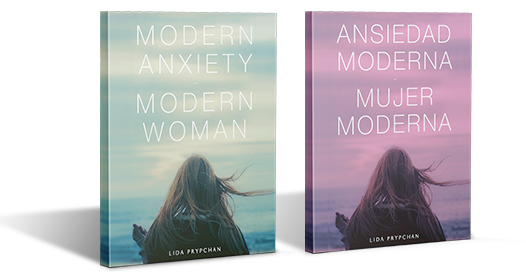
____ Order ____
Now
on Amazon.com
___ Books ___
Reviews
Modern Anxiety / Moder Woman:
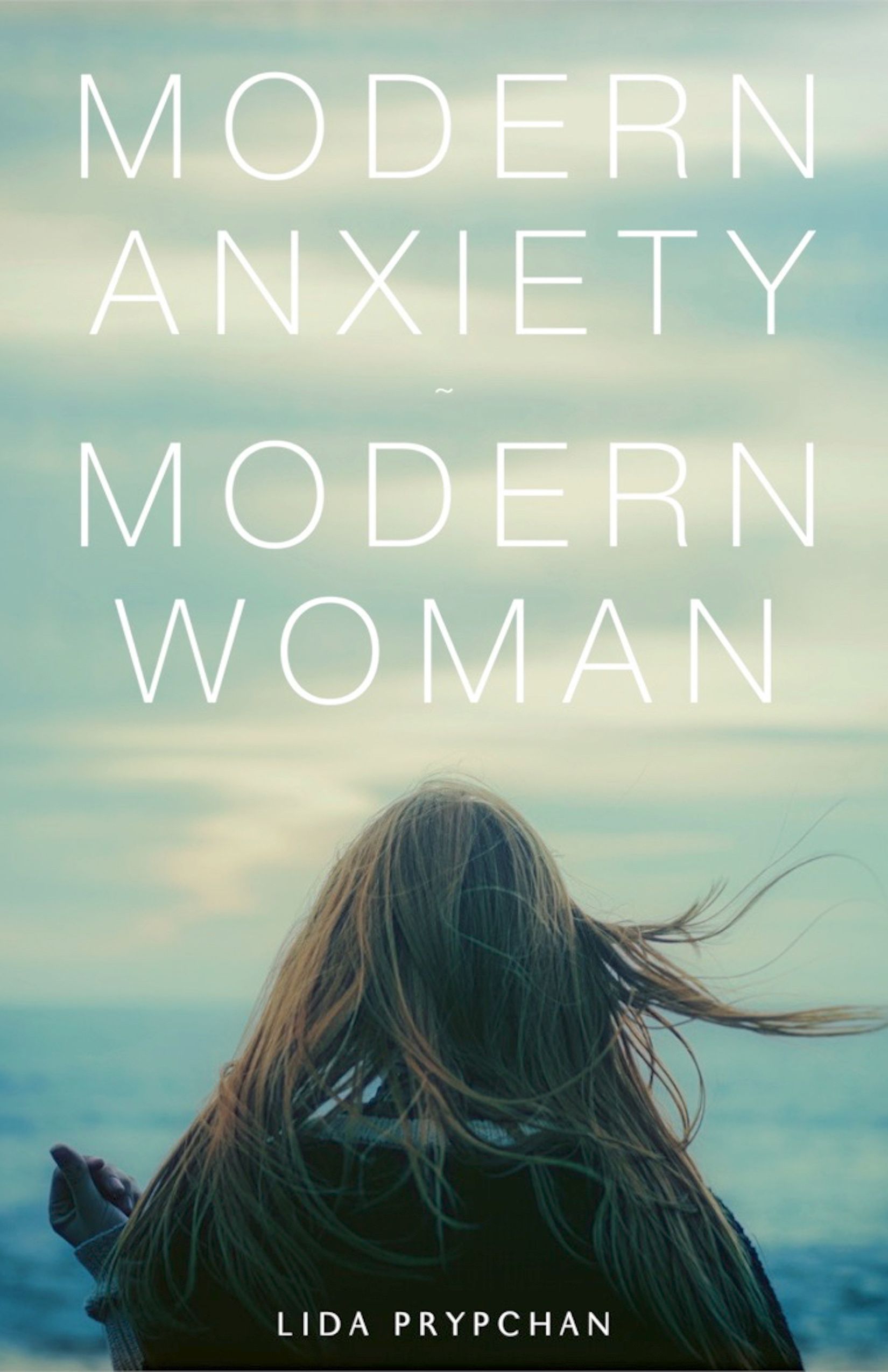
A collection of essays by Lida Prypchan “This collection of essays spans many years. Roughly divided into fiction, criticism and a wider social analysis, these pieces are an attempt to express what I see. In literature, in film, in history and in life - I have tried to elucidate patterns, and exceptions, with some psychological coherence.” - Lida Prypchan
Why Modern Anxiety? Anxiety has always been with us, but what is anxiety in a technological society? If our tolerance for sensory stimulus is finite, when do we reach breaking point in our frenetic world with its 24 hour media, its visual onslaught, its relentless material aspiration? If happiness is found in moderation, what becomes of us in a world of extremes?
Why Modern Woman? There is a focus in these pieces on the outer reaches, or extremes, of the romantic experience – impossible love, tragic love, disappointments that scar us for life. Are these ‘female’ themes, or simply attempts to describe the most human of experiences? Undoubtedly we see more writing by and about women, but after millennia of silence, of being almost entirely undocumented and without context – do we even know what a woman is? Ecclesiastes says there is no new thing under the sun, but perhaps a new perspective is possible – and what a weary world needs most.
Modern Anxiety, Modern Woman: Australia: A collection of essay by girls aged 15-25, with an Introduction by Lida Prypchan
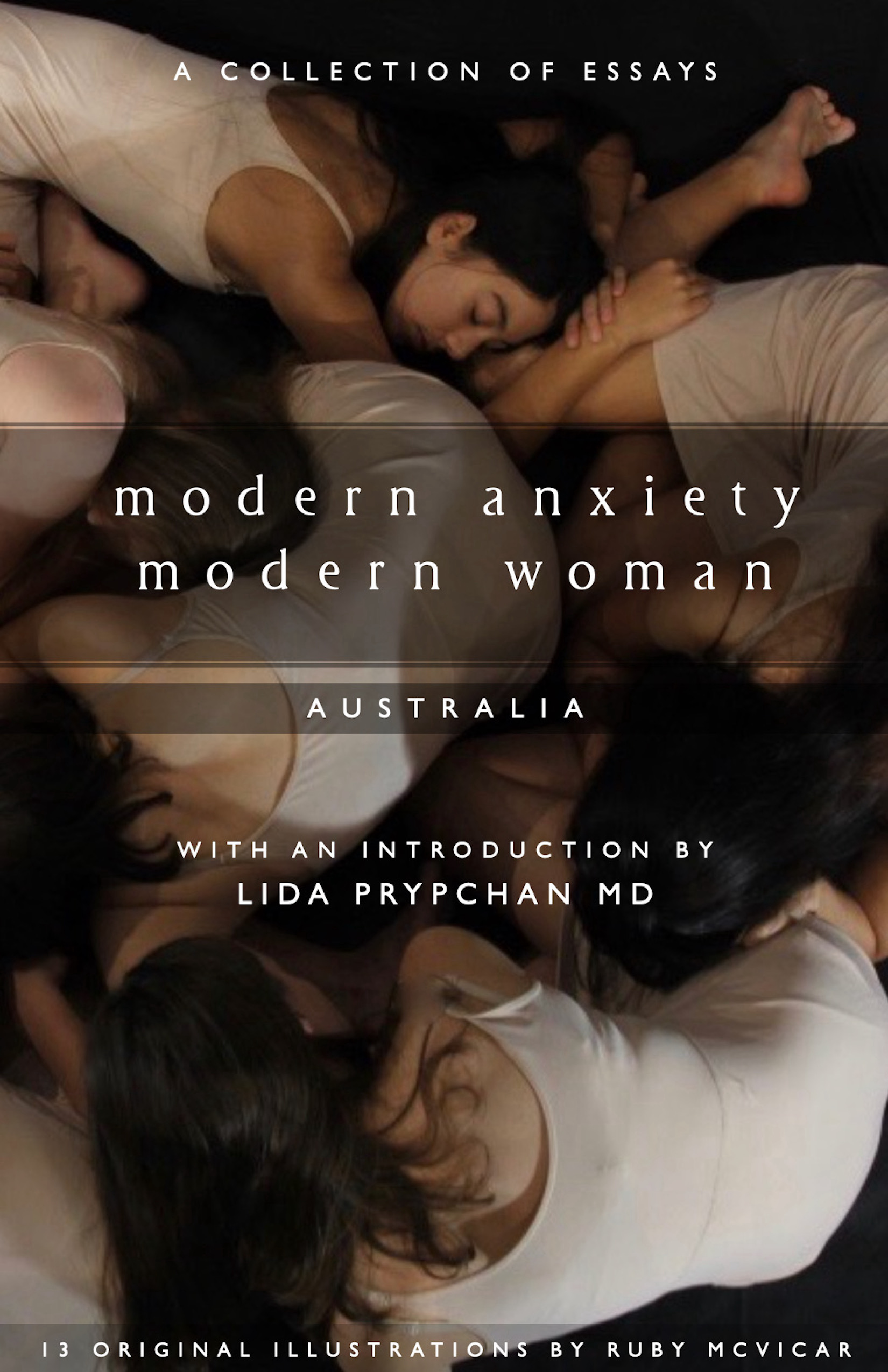
In May 2020, with the pandemic in its early months, Non Profit organisations Psychiatry, Philoso phy the Arts and The House That Dan Built launched a writing competition for Australian girls aged 15 25 on the theme s of anxiety and creativity. The response was overwhelming. Featured here are the thirteen selected essays which reflect, with startling honesty and acuity, what it is to be a young woman in increasingly uncertain times.
“I have described anxiety as the destruction of thought. Subjectively, it is a state of uncertainty, apprehension and helplessness in the face of a vague or imprecise danger. In itself, anxiety is not abnormal; it’s a natural response to a situation that threatens us. Anxiety becomes irrational when we exaggerate the response – when, in all or in the majority of our activities, we allow it to destroy our thoughts. Here, the matter is complicated as extreme anxiety can easily lead us to depression – or even to suicide. Anxiety is worrying in young people as it interrupts and distorts a critical time in their development. On a more human level, it robs them of what could, and should, be a relatively unencumbered time in their lives. Anxiety in the young is a waste of joy.” – Lida Prypchan.
___ About ___
Lida Prypchan
Welcome. I am Lida Prypchan MD, attending psychiatrist at the Wyoming Behavioral Institute in Casper, Wyoming. I specialize in Adult, Child and Adolescent Psychiatry with over two decades of experience. I began as early as my teen years, conduct ing patient interviews for my father in his psychiatric practice in my homeland, Venezuela.
After obtaining my M.D. degree at the University of Carabobo in Venezuela, I made the move to Pittsburgh, Penn., where I lived for six years. I was fortunate to work as a research associate with Matcheri Keshavan, M.D. in the field of schizophrenia then with Duncan Clark, M.D. in the field of anxiety disorders in children and adolescents with substance abuse at Pittsburgh Adolescent Alcohol Research Center. Later, I joined Juan Mezzich, M.D. and worked on several World Psychiatric Association projects on Diagnostic Classification Systems in Psychiatry at the University of Pittsburgh’s Western Psychiatric Institute and Clinic.
To sum up my background, I was trained at the University of Carabobo as a doctor; and as a psychiatrist at the Central University of Venezuela, Harvard University and the Monte Sinai School of Medicine in New York City where I also worked for two years in Child and Adolescent Psychiatry.
My thesis, titled “Karl Gustav Jung and Family Therapy, presented in December 1999, won 3rd place at UCV and I have written over 150 published articles. I m very proud to be a three time recipient of the National Award of Scientific Journalism in Venezuela.
Today, I write about the interrelationship between Psychiatry, Philosophy and the Arts for my non profit organization Psychiatry Philosophy Arts (PP+ The‘ Modern Anxiety, Modern Woman ’ ( series is the most recent of our publications, featuring an initial anthology of my essays,
both clinical and literary in their scope.
Under the MAMW umbrella, the PP+A team and I are now seeking to empower young women around the world by inviting them to share their experience of anxiety. How do they use the art s to mitigate the associated challenges? How do they ‘use ’anxiety as a force for creative expression?
We are currently working with young women in South America, Wyoming USA and other parts of the world and looking forward to taking our PP+A mission even further afield:
1) To promote the connections between our three pillars: psychiatry, philosophy and the arts.
2) To provide a safe space for discussion about the mind, psychiatric conditions, philosophy and the impact of art on mind and spirit.
… on Philosophy
“My Buddhist practice and my Master and Disciple relationship with my father and other mentors have been paramount to my development as a human being and therefore as a psychiatrist… I wouldn’t have been able to overcome the challenges I met under the pressure of passing rigorous exams as a student who was older than most, if not all, of her U.S. medical school classmates if I hadn’t begun to practice Buddhism.”
“When I began my practice in 1988, I felt as though I was a leaf spun around by the wind, but 20 years later, I feel more like a tree, robust and rooted in the ground of reality.”
“Life
is a search, a seeking spirit, seeking conclusion. What we want is to find freedom, peace and to manifest our potential… How can this be accomplished? Through unification, not compartmentalization.”
… on the Arts
“I very much enjoy the literary and visual arts. When I’m not practicing psychiatry, I spend a good deal of my time reading books (especially biographies) and seeing movies that explore a combination of psychiatric and philosophical themes.”

“Life is a search, a seeking spirit, seeking conclusion. What we want is to find freedom, peace and to manifest our potential… How can this be accomplished? Through unification, not compartmentalization.”
___ Arts ___
Inspirational Books

The Art of Seduction.
Author: Robert Greene.
Thousands of years ago, power was mostly gained through physical violence.
Men had one weakness: their insatiable desire for sex. Once a woman gave in to sex the man was back in control. If she withheld sex, he could simply look elsewhere. There were women whose hunger for power was too great. Women through much cleverness and creativity invented seduction. These experts in seduction would lure men away from the masculine world of war and politics and introduce them to the feminine world of luxury, spectacle, and pleasure.
There are seven types of seduction:
The Siren
In her presence, which is always sexually charged, the male feels transported to a world of pure pleasure. Cleopatra was the typical example. She had the ability to distract men. She would constantly transform herself before their eyes. Her voice was intoxicating. She was larger-than-life. Then, all of a sudden she would turn distant and angry. You never possessed Cleopatra, you worshiped her. The symbol of the Siren is Water. Like the sea, the siren lures you with the promise of infinite adventure and pleasure.
The Rake
When the Rake desires a woman he will go to the ends of the earth for her. The Rake is delightfully unrestrained, a slave to his love of women. Words are a woman’s weakness, and the Rake is a master of seductive language. The symbol is Fire. The Rake burns with a desire that enflames the woman he is seducing. It is extreme, uncontrollable, and dangerous.
The Ideal Lover
Most people have dreams in their youth that get shattered. Ideal lovers thrive on people’s broken dreams. The Ideal Lover reflects your fantasy. He or she is an artist in creating the illusion you require, idealizing your portray. The symbol is the Portrait Painter. He brings out noble qualities in you, frames you in a myth, makes you godlike, immortalizes you.
The Dandy
The Dandy create their own persona. They can’t be categorized. They have a startling physical image; they are mysterious and elusive. They appeal to the narcissism of each sex: to a woman they are psychologically female, to a man they are male. The symbol is the Orchid. Its shape and color oddly suggest both sexes. Delicate and highly cultivated, it is prized for its rarity.
The Natural
The Natural embodies the longed-for qualities of childhood—spontaneity, sincerity, pretentiousness. We feel at ease. They also make a virtue out of weakness, making us protect them. The symbol is the soft and endearing Lamb. Its weakness is part of its charm; is pure innocence; it is so innocent we want to possess it, even devour it.
The Coquette
The Coquette delays satisfaction. They orchestrate a back-and-forth movement between hope and frustration. They promise an elusive reward. The strategy of the Coquette is never to offer total satisfaction. They alternate heat and coolness. The symbol is the Shadow. It cannot be grasped. After they have given us pleasure, the shadow of their withdrawal makes us yearn for their return, much as clouds make us yearn for the sun.
The Charmer
Charm is seduction without sex. They are manipulators that create a mood of pleasure and comfort. They focus on you as their target. You feel better about yourself when with them. By drawing you in with their indulgence they make you dependent on them. They center on your vanity and self-esteem. The symbol is the Mirror. Your spirit holds a mirror up to others. When they see you they see themselves: their values, their tastes, even their flaws. Their lifelong love affair with their own image is comfortable and hypnotic; so feed it. No one ever sees what is behind the mirror.
The Charismatic
Its presence excites us. Its qualities radiate outwardly. They are a combination of self-confidence, sexual energy, sense of purpose, and contentment. They radiate intensity while remaining detached. They have a piercing gaze, fiery oratory, an air of mystery. The symbol is the Lamp. Invisible to the eye, a current flowing through a wire in a glass vessel generates heat that turns into candescence. All we see is the glow. In the prevailing darkness, the Lamp lights the way.
The Star
Life is harsh. Fantasies and dreams are our ways to escape. Stars have an elusive presence, are vague, ethereal, distant, objects of fascination, and entice us to imagine more than is there. Their dreamlike quality works on our unconscious. The symbol is the Idol. A piece of stone carved into the shape of a god. The eyes of the worshippers fill the stone with life, imagining it to have real powers. Its shape allows them to see what they want to see—a god— but it is actually just a piece of stone. The god lives in their imaginations.

Too Scared to Cry- Lenore Terr, MD
Author: Edgar Allan Poe
Edgar's father (David Poe) was an actor. He left his wife Elizabeth when Edgar was 18 months old.
Edgar’s father was too sick with tuberculosis; he died shortly after abandoning his pregnant wife and son. They arrived in Richmond in 1811. They were poor. Mother had to work as an actress and dancer. Elizabeth Poe had tuberculosis and she was dying. This pretty woman was not dying a pretty death. Edgar was watching a beloved, beautiful woman fade away. He was seeing blood on her handkerchiefs, towels, and nightgowns. Then Elizabeth died. He was taken away by the person who became his foster mother and the reason for his middle name, Mrs. Frances Allan. Little Edgar witnessed the moment his mother died and for the minutes and hours that followed. Poe describes death the way a traumatized toddler would view it— as an uncertain, transitory state that looks like sleep, were it not so stiff, so ugly, and so quiet. Edgar may have lain down with his mother’s body, nestled into her, talked to her, shook her, perhaps even tried to open her mouth. He did not understand what death was. But he formed a permanent impression. As an adult author, Poe tended to kill off his beautiful fictitious women in comatose, sleep-like states; he buried his people alive. Poe, the inventor of the mystery story and an early expert at the art of horror fiction, was a simultaneously bereaved and traumatized child. Poe’s mother was his eternal love. At the same time, she was his horror. Poe dreamed terrible nightmares of white-robed women coming to get him. He set up an almost certain death scene by marrying his 13-year-old cousin. She, like Poe’s mother, was already very obviously destined to die of tuberculosis. And Poe almost recreated for himself scenes he had observed with his mother by drinking himself comatose and taking opium to the point of stupor. One night say that Poe killed himself by reenacting his trauma.
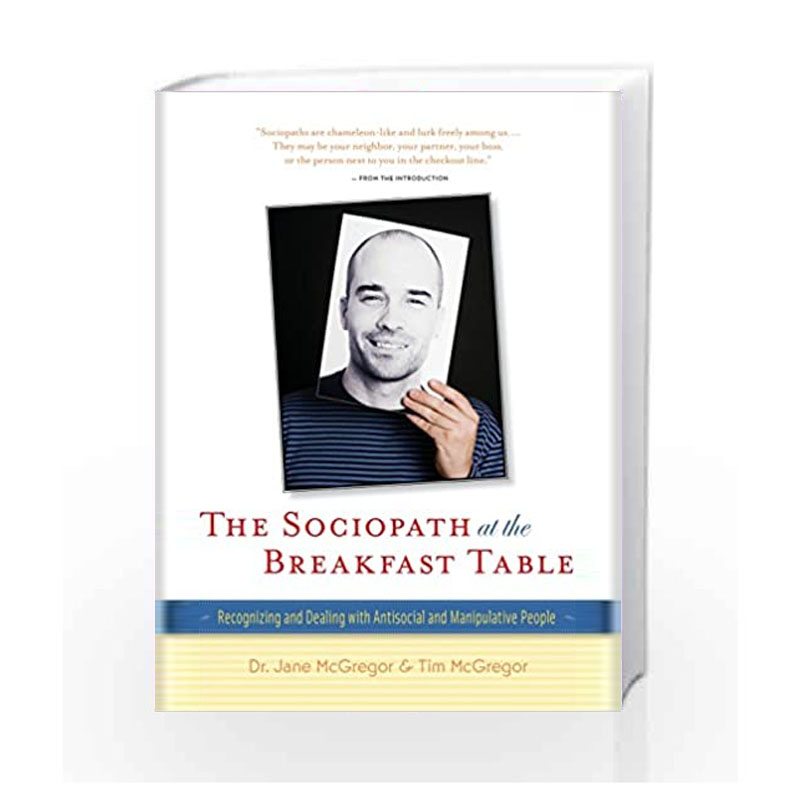
The sociopath at the breakfast table
Author: Dr. Jane McGregor & Tim McGregor
About: Stanley Milgram's Yale University Professor experiment in 1960.
(Here, I am including a very interesting section described in this book)
In 1960, Yale University Professor Stanley Milgram set up an experiment to test de human propensity to obey orders. A person playing the role of a “teacher” was given a list of word pairs that he was to teach the “learner.” The teacher was then given an electric shock from an electro-shock generator as a sample of the shock that the learner would supposedly receive in response to wrong answers.// There were four possible answers. If the answer was incorrect, the teacher would administer a shock to the learner, with the voltage increasing incrementally for each wrong answer. The subjects believed that for each wrong answer, the learner was receiving an actual shock. In fact, there were no shocks. The experiment was stopped after the learner had been given the maximum 450-volt shock three times in succession. // Afterward, Milgram summarized the experiment in an article for Harper’s titled “The Perils of Obedience.”
“Ordinary people, simply doing their jobs, and without any particular hostility on their part, can become agents in a terrible destructive process. Moreover, even when the destructive effects of their work become patently clear and they are asked to carry out actions incompatible with fundamental standards of morality, relatively few people have the resources needed to resist authority.”
Inspirational Songs

Artist: Annie Lennox
Something So Right
Lyrics: You've got the cold water When the fever runs high And you've got the look of love Right in your eyes And I was in a crazy motion Till you calmed me down It took a little time But you calmed down...
…Some people never say the words
“I love you”
But like a child
They’re longing to be told
They’ve got a wall in a China
It’s a thousand miles long
To keep out the foreigners
They made it strong
And I’ve got a wall around me
That you can’t even see
It took a little time
To get next to me.
General Comment: ...
Love takes time. Trust is earned. Details are needed.
He alleviates her fever with cold water. He is able to calm her down when she is in a crazy motion. She is not used to saying I love you but she longs to be told.
The Wall of China is a metaphor that lets us know that she has a wall around her that nobody can’t see.
It took a little time to get next to her and this is the power of love.
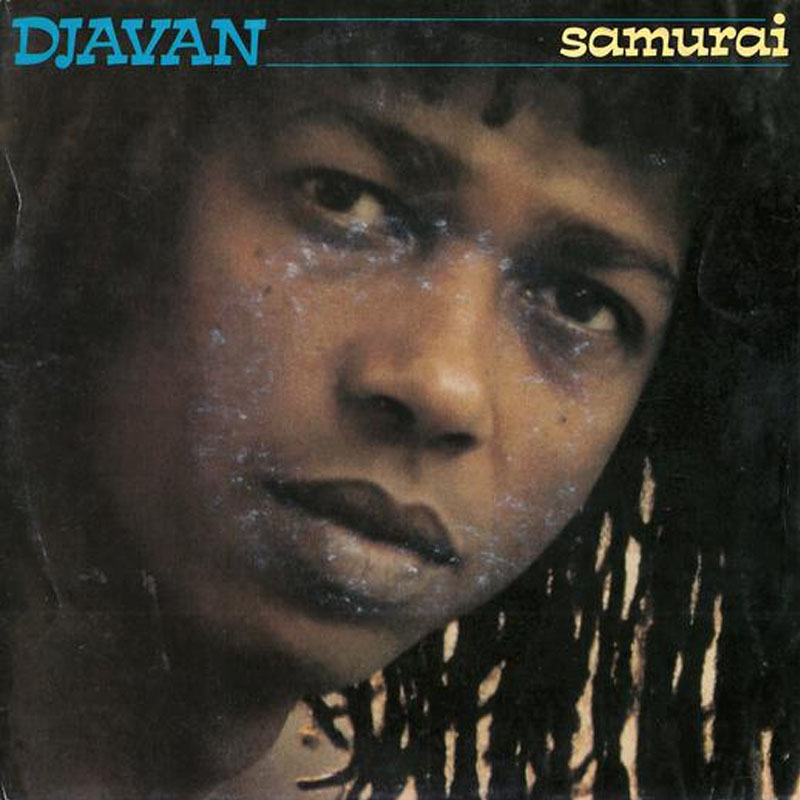
Artist: Djavan
Samurai
Lyrics In spanish: Ay cuanto amor cabe en mi corazon Me hace sufrir Se va sin decirme Se va cuando quiere Y me acaricia la piel Crece,
La luz de la luna Para iluminar la oscuridad En lo profundo de la passion Queria luchar Contra el poder del amor Cai a los pies del vencedor Para ser el servidor De un Samuria Ay cuanto amor cabe en mi corazon
General Comment: ...
Mi comentario:
Esta cancion dice que quien intente resistirse al amor, termino rendido a sus pies, a los pies del Samurai.
—————————————————
La palabra samurai deriva del japones saburou que significa “proteger” o “servir” …Los samurais se caracterizan por su fuerte codigo de etica regido por el codigo bushido que representaba “el camino del guerrero”
El Codigo Bushido es un codigo etico muy estricto compuesto por 7 principios:
Intregridad, respeto, valor, honor, compassion, honestidad y lealtad.
Estos 7 principios permitieron a los Samurai ser los hombres mas poderosos y fieros de su epoca, y a la vez los mas justos y honorables.
______________________________
Source: www.entrepreneur.com———- Isabel Padilla……..lo que viene a continuacion…un resumen…
Las virtudes del Bushido para seguir el Camino del Guerrero:
JUSTICIA: Solo existe lo correcto y lo incorrect.
VALOR HEROICO: Reemplaza el miedo por el respeto y la precaucion.
COMPASION: El samurai debe ayudar a sus hermanos en cualquier oportunidad.
CORTESIA: Un samurai siempre debe ser cortes, especialmente hacia sus enemigos. Sin esta muestra directa de respeto hacia sus oponentes, el samurai no es mejor que los animals. El samurai es temido por su fuerza en la batalla, pero es respetado por su manera de tratar a los demas.
HONOR: El autentico samurai solo tiene un juez de su honor: el mismo. Nadie puede ocultarse de si mismo, y los samurais no son una excepcion.
SINCERIDAD ABSOLUTA: Cuando un samurai dice que hara algo, es como si ya estuviera hecho.“Hablar” y “hacer” son la misma accion.
DEBER Y LEALTAD: Las palabras de un samurai son como sus huellas: puedes seguirlas donde quiera que el vaya, es por esto que debe tener cuidado con el camino que elija.
______________________________
Artista: Djavan, un cantante Brasileno de fama internacional, tiene una cancion titulada Samurai. Es una cancion llena de vida y entusiamo expresada con su ritmo. Su melodia es pegajosa. Sus primeras lineas dicen “Cuanto querer cabe en mi Corazon” y eso me hace pensar en mi sobrino Daniel pues su Corazon esta lleno de amor y compassion.
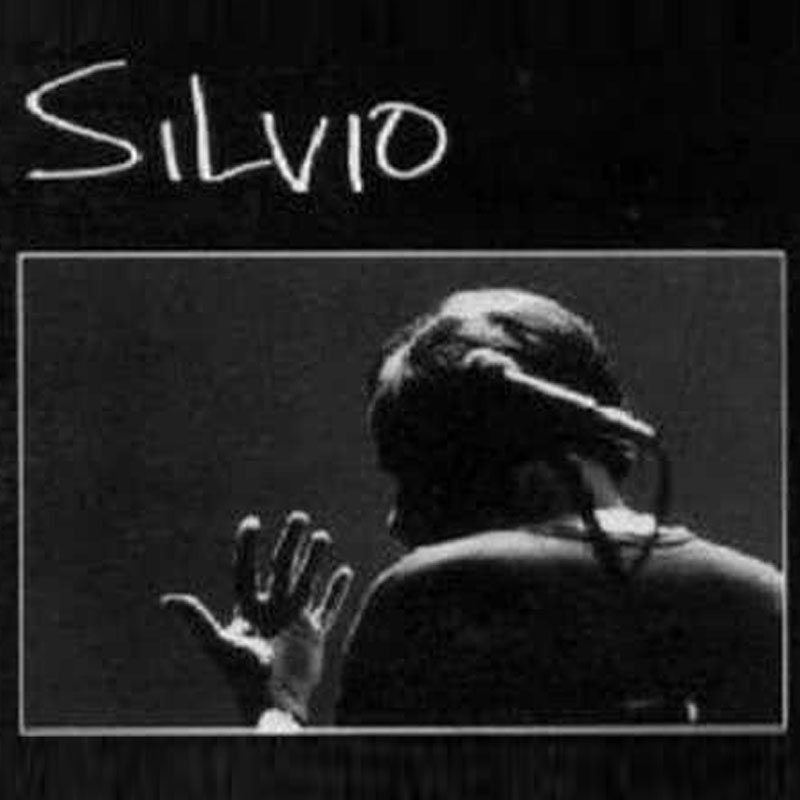
Artist: Silvio Rodriguez
La Maza
Lyrics: Si no creyera en la locura De la garganta del sinsonte Si no creyera que en el monte Se esconde el trino y la pavura
Segunda estrofa
Si no creyera en la balanza
En la razón del equilibrio
Si no creyera en el delirio
Si no creyera en la esperanza
Tercera estrofa
Si no creyera en lo que agencio
Si no creyera en mi camino
Si no creyera en mi sonido
Si no creyera en mi silencio
Cuarta estrofa
Si no creyera en lo mas duro
Si no creyera en el deseo
Si no creyera en lo que creo
Si no creyera en algo puro
Quinta estrofa
Si no creyera en cada herida
Si no creyera en lo que ronde
Si no creyera en lo que esconde
Hacerse hermano de la vida
Sexta estrofa
Si no creyera en quien me escucha
Si no creyera en lo que duele
Si no creyera en lo que quede
Si no creyera en lo que luche.
General Comment: ...
Para mi esta canción expresa la importancia de ser uno mismo, de ser fiel a lo que uno ama, de abrirse camino en un mundo en lo que todo se critica y desvaloriza.
Esta canción significa la importancia de tener una misión en la vida como psiquiatra o como cantante. Cantar es llorar a puro pulmón lo que uno siente en lo hondo de su corazón
Primera estrofa:
El psiquiatra asi como el cantante están al tanto de la locura en el mundo. No cualquiera pueda estar rodeado de la locura existente en el mundo.Han existidos locos prodigiosos que han cambiado la visión de nuestras vidas.
Segunda estrofa:
Para ser un ser especial, es necesario tener esperanza y equilibrio en esta loca marasma llamada vida.
Tercera estrofa:
Es imperante poseer una misión, un camino, un sonido y saber cuando es el mejor momento para guardar silencio.
Cuarta estrofa:
No hay otro remedio que enfrentarse con lo duro de la vida, conocer lo placentero, una quimera ya sea real o imaginaria. En la mente del artista esto representa lo que es para ellos más puro, sus mas intimos deseos y creencias.
Quinta estrofa:
Solo las heridas enseñan lo que el artista esconde en lo más intimo de sus existencia. Esto es lo que los conduce a hacerse hermanos de la vida.
Sexta estrofa:
Quien escucha al artista es afortunado pues
el artista describe lo que está en el alma, lo que duele, lo que es luchar independientemente de lo que quede.
Final
Inspirational Paintings
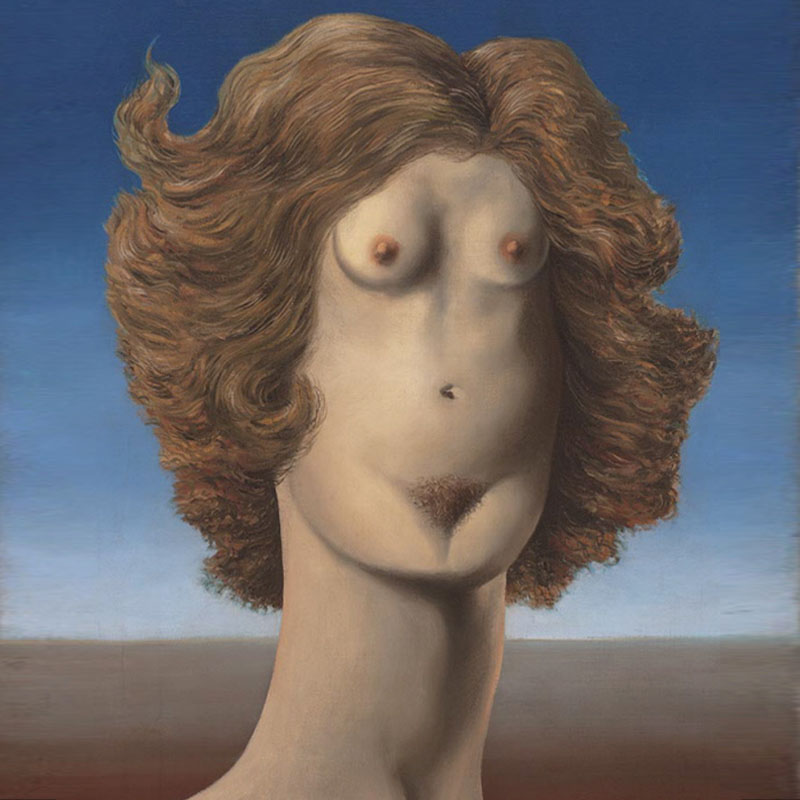
The Rape
Author: Rene Magritte
By Lenore Terr. Rene was 14 years old when his mother committed suicide.
He decided to be a painter at the age of 12.
The mother suffered from bouts of depression with suicidal ideation.
One night his mother slipped away.
A day or two later her body was found in the Sambre River.
The suicide of a parent is an unusually shocking experience for a child.
Rene didn’t like to talk about the suicide of his mother. Indeed, he manifested that his mother’s suicide was not traumatic to him.
However, his painting said the opposite. In his paintings, he offered visual memories from his experience.
Rene was fascinated with coffins.
“His painting The Rape, done in 1945, shows a woman’s face with breasts for eyes, navel for nose, and genitals for mouth.
It is a horrible looking thing too gruesomely close to a fourteen-year-old boy’s shocking impression of the exposed trunk of his mother’s naked body for comfort.
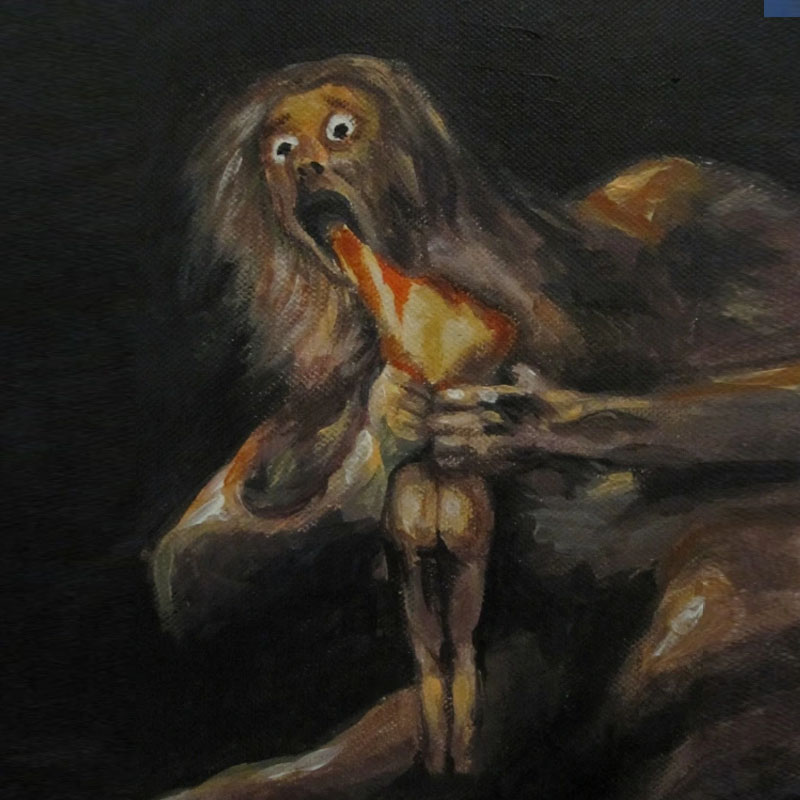
Saturn Devouring his child.
Author: Francisco de Goya
The painting is difficult to see because for me it means the death of a son who instead of being loved is eaten by his father.
It is diametrically opposite to what a relationship between a father and a son should be. This painting made me think of children who are not independent from their father.
It also makes me think of a father who hates himself and therefore hates what is similar to him. I have seen this phenomenon on several occasions. And it is that the children at a certain time must become independent because otherwise they are eaten by their parents to punish and annihilate them.
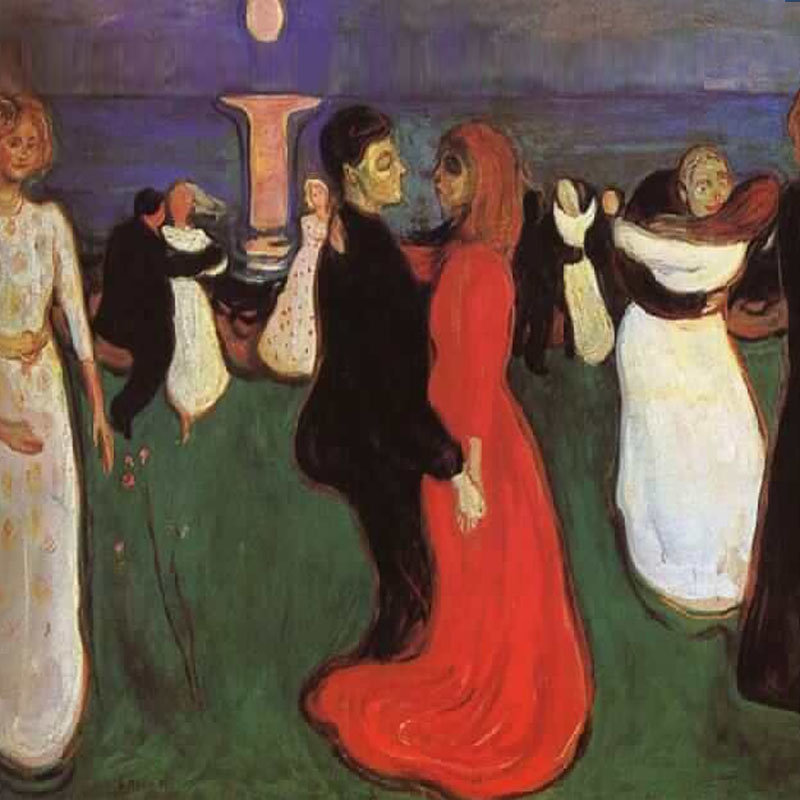
The Dance Of Life
Author: Edvard Munch
In this painting, there is an innocent woman in white on the left, a sensual woman dancing with a man, and an anguished woman in black on the right.
All three resemble Tulla Larsen who had a love relationship with Munch.
Their relationship lasted only four years. It was tormenting, painful and devastating for both of them.
It seems, pretending to give an explanation that Munch wanted to present the three stages of the same relationship with Tulla Larsen.
The first was the innocence when two human beings encounter one another and want to get to know each other. Then, the second is courtship which is the sensual aspect of a relationship.
This second stage usually ends in the sexual relationship between these two persons. Then, the third and last one is the death of the relationship and this is why the woman is dressed in black.
This painting also makes me think about how when people dance they become one with each other. It is usually initiated with a first encounter. They get to know each other expressing who each one is, what they like and dislike. Once a friendship is formed they go into the second stage. In this second stage, the sensual courtship and the seduction take place together with the consumption of sex.
Then in the third stage, the relationship goes into a crisis that could be resolved or can end the relationship.




